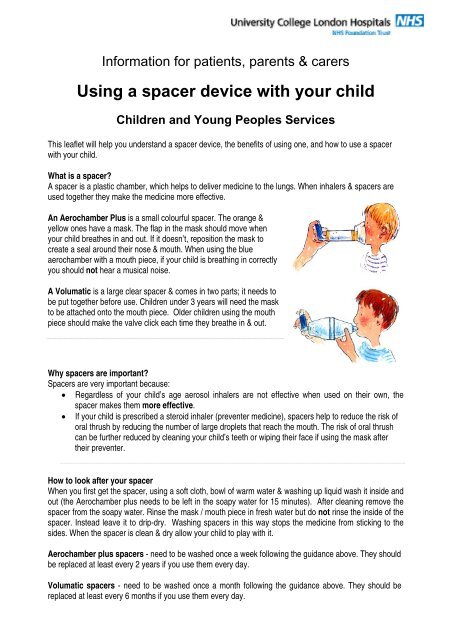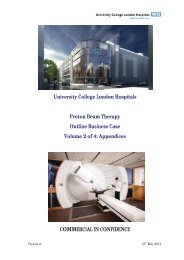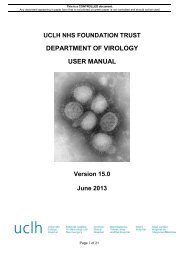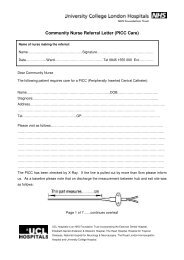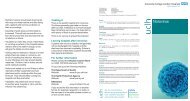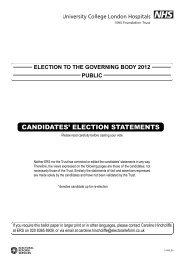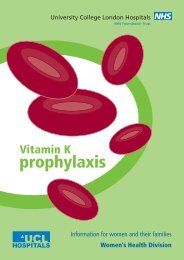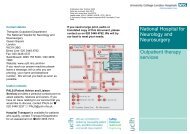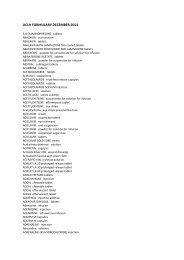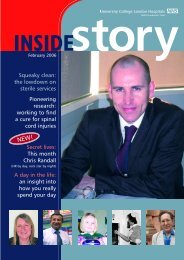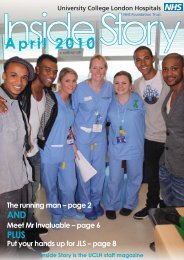Using a spacer with your child - University College London Hospitals
Using a spacer with your child - University College London Hospitals
Using a spacer with your child - University College London Hospitals
Create successful ePaper yourself
Turn your PDF publications into a flip-book with our unique Google optimized e-Paper software.
Information for patients, parents & carers<br />
<strong>Using</strong> a <strong>spacer</strong> device <strong>with</strong> <strong>your</strong> <strong>child</strong><br />
Children and Young Peoples Services<br />
This leaflet will help you understand a <strong>spacer</strong> device, the benefits of using one, and how to use a <strong>spacer</strong><br />
<strong>with</strong> <strong>your</strong> <strong>child</strong>.<br />
What is a <strong>spacer</strong>?<br />
A <strong>spacer</strong> is a plastic chamber, which helps to deliver medicine to the lungs. When inhalers & <strong>spacer</strong>s are<br />
used together they make the medicine more effective.<br />
An Aerochamber Plus is a small colourful <strong>spacer</strong>. The orange &<br />
yellow ones have a mask. The flap in the mask should move when<br />
<strong>your</strong> <strong>child</strong> breathes in and out. If it doesn’t, reposition the mask to<br />
create a seal around their nose & mouth. When using the blue<br />
aerochamber <strong>with</strong> a mouth piece, if <strong>your</strong> <strong>child</strong> is breathing in correctly<br />
you should not hear a musical noise.<br />
A Volumatic is a large clear <strong>spacer</strong> & comes in two parts; it needs to<br />
be put together before use. Children under 3 years will need the mask<br />
to be attached onto the mouth piece. Older <strong>child</strong>ren using the mouth<br />
piece should make the valve click each time they breathe in & out.<br />
Why <strong>spacer</strong>s are important?<br />
Spacers are very important because:<br />
Regardless of <strong>your</strong> <strong>child</strong>’s age aerosol inhalers are not effective when used on their own, the<br />
<strong>spacer</strong> makes them more effective.<br />
If <strong>your</strong> <strong>child</strong> is prescribed a steroid inhaler (preventer medicine), <strong>spacer</strong>s help to reduce the risk of<br />
oral thrush by reducing the number of large droplets that reach the mouth. The risk of oral thrush<br />
can be further reduced by cleaning <strong>your</strong> <strong>child</strong>’s teeth or wiping their face if using the mask after<br />
their preventer.<br />
How to look after <strong>your</strong> <strong>spacer</strong><br />
When you first get the <strong>spacer</strong>, using a soft cloth, bowl of warm water & washing up liquid wash it inside and<br />
out (the Aerochamber plus needs to be left in the soapy water for 15 minutes). After cleaning remove the<br />
<strong>spacer</strong> from the soapy water. Rinse the mask / mouth piece in fresh water but do not rinse the inside of the<br />
<strong>spacer</strong>. Instead leave it to drip-dry. Washing <strong>spacer</strong>s in this way stops the medicine from sticking to the<br />
sides. When the <strong>spacer</strong> is clean & dry allow <strong>your</strong> <strong>child</strong> to play <strong>with</strong> it.<br />
Aerochamber plus <strong>spacer</strong>s - need to be washed once a week following the guidance above. They should<br />
be replaced at least every 2 years if you use them every day.<br />
Volumatic <strong>spacer</strong>s - need to be washed once a month following the guidance above. They should be<br />
replaced at least every 6 months if you use them every day.
How do I use a <strong>spacer</strong> <strong>with</strong> my <strong>child</strong>?<br />
1. Shake the inhaler well.<br />
2. Fit the inhaler into the hole at the end of the <strong>spacer</strong>.<br />
3. If <strong>your</strong> <strong>child</strong> is 3 years old or above place the mouth piece between <strong>your</strong> <strong>child</strong>’s teeth & get them to<br />
close their lips. For <strong>child</strong>ren under 3 years place the mask over their face to create a seal around the<br />
nose and mouth.<br />
4. Press the inhaler once and allow <strong>your</strong> <strong>child</strong> to take five breaths in and out of the <strong>spacer</strong> if <strong>your</strong> <strong>child</strong> is<br />
using the mouth piece. If <strong>your</strong> <strong>child</strong> is using a mask, count out loud to 10.<br />
5. Remove the <strong>spacer</strong> from <strong>your</strong> <strong>child</strong>’s mouth / face.<br />
Repeat steps 1 to 5 for each puff. The doctor, nurse or pharmacist will tell you how many puffs are needed<br />
and how often you need to give it. Always check <strong>with</strong> them if you are not sure and ask them to write it<br />
down.<br />
Remember… Only put one puff of medicine into the <strong>spacer</strong> at a time. If you put in more than one puff, the<br />
droplets of spray stick together and coat the sides of the <strong>spacer</strong> which means <strong>your</strong> <strong>child</strong> won’t breathe them<br />
in.<br />
Top tips for babies<br />
Giving babies their inhalers can be challenging. If you are finding it difficult to use a <strong>spacer</strong> and mask you<br />
can try the following:<br />
<br />
<br />
<br />
<br />
<br />
<br />
<br />
<br />
Play <strong>with</strong> the <strong>spacer</strong> before you need to use it, so that she/he gets used to the feel of it.<br />
Be positive and smile. Your baby will know if you are anxious.<br />
Try to avoid giving inhalers to <strong>your</strong> baby if they are crying as they won’t get very much medicine.<br />
If <strong>your</strong> baby is wiggly, cuddle <strong>your</strong> baby on <strong>your</strong> knee or cradle them in <strong>your</strong> arms. You can tuck<br />
one of their arms out of the way, <strong>with</strong> <strong>your</strong> spare hand you can gently hold their other hand to stop<br />
them knocking the mask away.<br />
If you are using a Volumatic <strong>spacer</strong>, hold the <strong>spacer</strong> at a 45 o angle to keep the ‘clicking’ valve<br />
<strong>with</strong>in the mouth piece open.<br />
Count out loud to 10 for each puff so they learn how long they need to tolerate it on their face for.<br />
At 10 remove the mask from their face, congratulate them & make them feel very clever!<br />
Inhalers can be given to <strong>your</strong> baby when they are asleep.<br />
Important contact details<br />
The UCLH Children’s Respiratory Nurses can be contacted by calling the trust switchboard on 0845 155<br />
5000 or 020 3456 7890 then Ext 77705. Or write to Paediatrics, 6 th Floor Central, 250 Euston Road,<br />
<strong>London</strong> NW1 2PG. If you would like more information you can contact Asthma UK on 020 7786 4900 or<br />
view their website at www.asthma.org.uk<br />
If you would like a large print, audio or translated version of this document<br />
please contact 0845 155 5000 or 020 3456 7890 (ext 77705). We will try<br />
our best to meet <strong>your</strong> needs.<br />
Date of publication, August 2011 Last review date: Aug 2011<br />
Next review date, August 2013<br />
Leaflet code: UCLH/SH/PAED/CYPS/SPACER/1<br />
©:<strong>University</strong> <strong>College</strong> <strong>London</strong> <strong>Hospitals</strong> NHS Foundation Trust 2011


